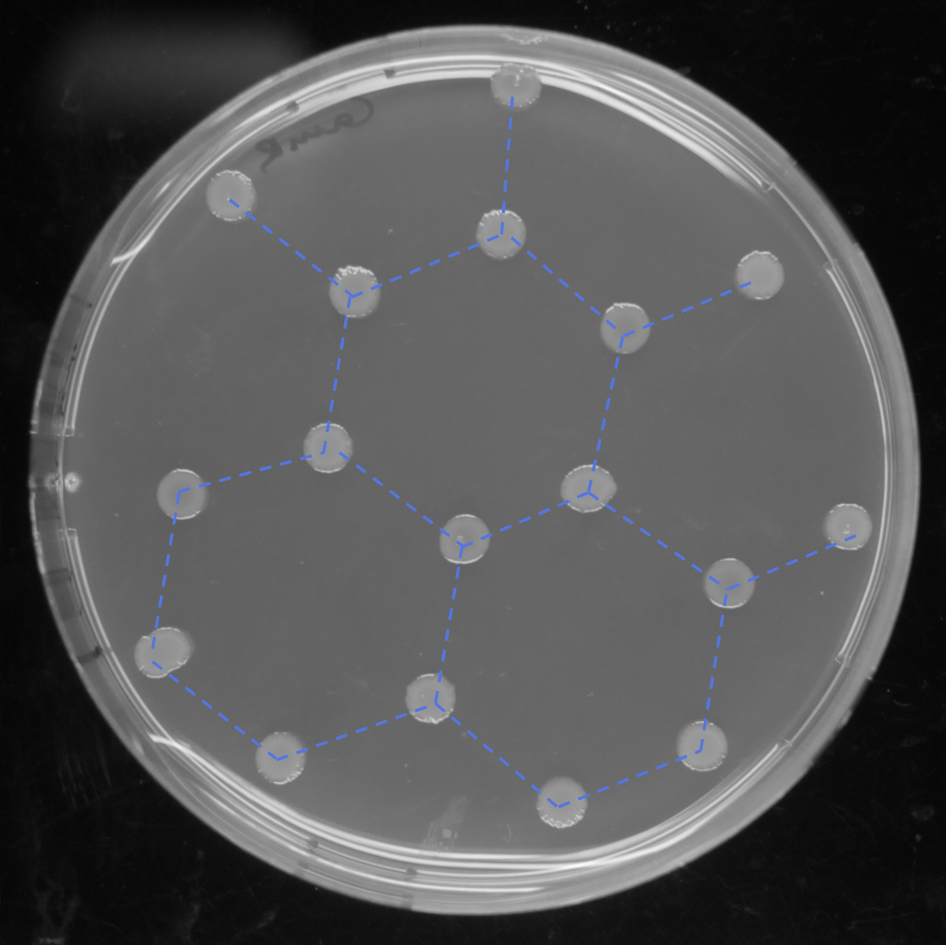Team:ETH Zurich/Project
From 2013.igem.org
Contents |
Want to play the biological Colisweeper game? Here's how to do it!
Gaining inspiration from the computer game Minesweeper, we aspire to incorporate the same rules in the biological version as well. To replicate the "mouse click" in the computer game, you can add a substrate to the colony of your choice that leads to an enzyme-susbtrate reaction that expresses the reporter.The agar mine field consists of colonies which can be one of the following:
a non-mine colony,
a non-mine colony located close a mine, when played will reveal the number of surrounding mines , which on addition of a multi-substrate reveals the number of mines in the vicinity of this colony
a dangerous and scary mine colony,which when played reveals the mine color and the game is over
You also have the option to flag a mine - if you are certain that a colony is a mine, you can flag this mine after which this colony cannot be played again and the game is continued.
And... how does Colisweeper work?
Each minesweeper square in the computer game corresponds to a bacterial colony on the agar mine-field. We have two bacterial strains: 1. the mine strain which are the sender cells and 2. the non-mine strain which are the receiver cells. The cells communicate through diffusion of OHHL and change color to give the player information in order to logically carry out the next move in the game. The colonies remain white as seen on the agar plate until any substrate is added. The left click and the right click of the mouse is simulated with the addition of the multi-substrate mix and the single substrate.
The biology is explained here. The sender colony secretes the quorum signal 3-oxo-N-hexanoyl-L-homoserine lactone (OHHL) that diffuses through the agar to the surrounding cells.The receiver cells receive the OHHL and convert the inactive luxR to active luxR by forming a complex OHHL-luxR. They proceed the information using a system composed of 3 mutated pLuxR promoters, with different affinities, responsible for the secretion of different hydrolases. The player can see by eye ,and in less than 5 minutes after addind the substrates, how many mine cells surround the cell he just played.
The Game Board
One last decision we had to make is the board layout. We knew we had to place E.coli colonies on an M9 agar plate in a regular symmetric pattern.
But what is the right pattern? The most intuitive one is the traditional minesweeper pattern with tightly spaced squares, where each cell can touch 8 different fields around it. That approach doesn’t work with our bacteria though. Our colonies send signal through the diffusion of chemicals (OHHL) and therefore they must be at the same distance to each other to get equal signal from the colonies right next to them.
In the traditional minesweeper pattern, if we located bacterial colonies in the middles of the squares, the cells touching only on the corners would be further away than the cells touching along the edges. The color-coded signals wouldn’t work anymore.
That’s why we came up with the hexagonal honeycomb-like pattern. All intersections and centers of the hexagons are at equal distances from the colonies around them. We can use our diffusion and trust our colors.
We can be sure our bacteria aren’t cheating!!
What about signaling and information processing ?
Signal expression by mine cells (sender cells)
Mine cells are a strain of E.coli bacteria that constitutively express the "mine-cell reporter” reacting with substrate #1 to produce the visual effect of being a mine. After substrate #1 is added the bacterial colony turns black, indicating our defeat.
At the same time, the mine cell is a sender module of OHHL. It has the LuxI preceded by a constitutive promoter, which induces OHHL expression. This means that the mine continuously produces OHHL, allowing it to gradually diffuse radially out to neighboring colonies. We use this attribute of our mine cells for quorum sensing in the surrounding bacterial cells.
Information processing by non-mine cells (receiver cells)
So what exactly happens with the expressed OHHL?
1. Receiver cells respond to low OHHL concentration
If one mine cell is close to the colony which is selected with substrate #1, the OHHL concentration induces a certain reaction. Thanks to a bandpass filter using the LuxR system, the cell is able to detect low concentrations of OHHL and activate a reporter signalling low OHHL concentration. The mine changes color to blue and the player (that’s you!) knows that one mine is close to the cell he had just revealed.
2. Receiver cells respond to high OHHL concentration
Now say there are two or more mine cells directly next to our chosen colony. There is therefore a proportionally higher concentration of diffused OHHL in the selected cell. The LuxR system works as a bandpass filter again and induces the expression of another reporter to show that 2 or more mines are surrounding the selected colony. The field changes color to green to signal that to the player. Ideally, thanks to the colors, the player is always sure how many mines surround an uncovered field.
3. Receiver cells signal no mines in their vicinity
If there are no mine cells directly next to a colony, it will not have any OHHL. The LuxR bandpass system will respond and the bacteria will express a reporter indicating that this is a "neutral" cell.
Flagging
Remember what the flagging does in a traditional minesweeper game? It helps us put a red flag on the dangerous spots without detonation!
If the player is sure about one colony to be a mine he has the option to flag it as a visual help. E.coli expressing constitutively express a reporter, which reacts with substrate #2 and changes the colony’s color to red.
Remember! Flagging doesn’t reveal any information about mines in neighbouring cells.
 "
"









